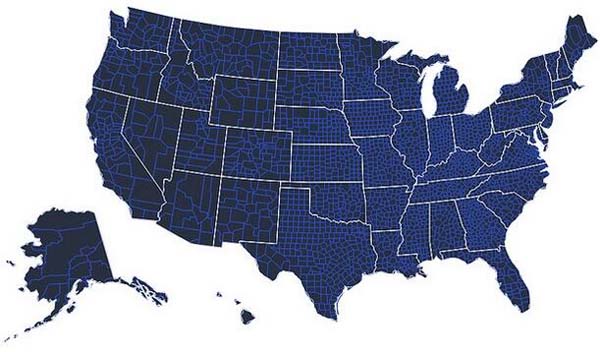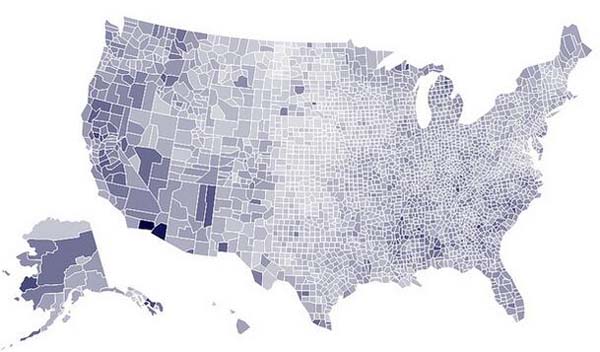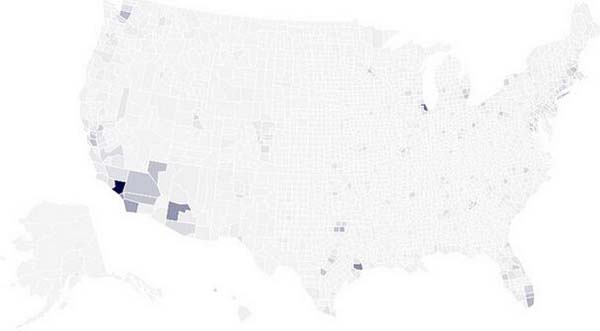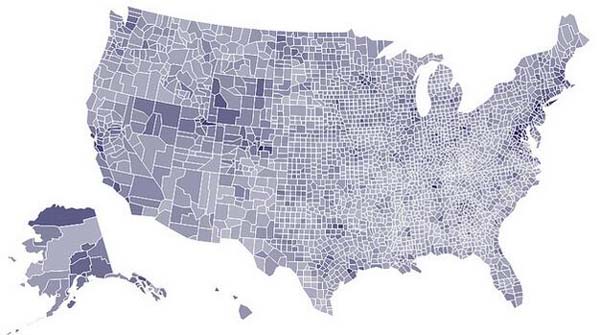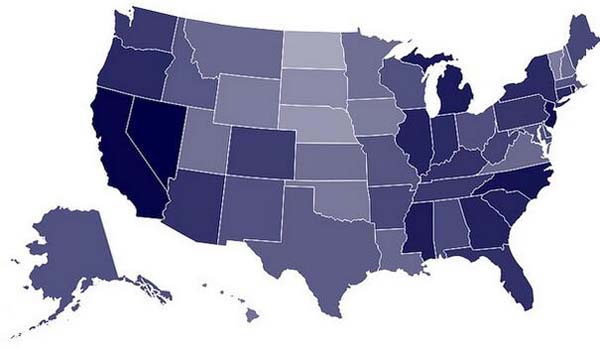import vincent
world_countries = r'world-countries.json'
world = vincent.Map(width=1200, height=1000)
world.geo_data(projection='winkel3', scale=200, world=world_countries)
world.to_json(path)
当我开始建造Vincent时, 我的一个目的就是使得地图的建造尽可能合理化. 有一些很棒的python地图库-参见Basemap 和 Kartograph能让地图更有意思. 我强烈推荐这两个工具, 因为他们都很好用而且很强大. 我想有更简单一些的工具,能依靠Vega的力量并且允许简单的语法点到geoJSON文件,详细描述一个投影和大小/比列,***输出地图.
例如, 将地图数据分层来建立更复杂的地图:
vis = vincent.Map(width=1000, height=800)
#Add the US county data and a new line color
vis.geo_data(projection='albersUsa', scale=1000, counties=county_geo)
vis + ('2B4ECF', 'marks', 0, 'properties', 'enter', 'stroke', 'value')
#Add the state data, remove the fill, write Vega spec output to JSON
vis.geo_data(states=state_geo)
vis - ('fill', 'marks', 1, 'properties', 'enter')
vis.to_json(path)
加之,等值线地图需绑定Pandas数据,需要数据列直接映射到地图要素.假设有一个从geoJSON到列数据的1:1映射,它的语法是非常简单的:
#'merged' is the Pandas DataFrame
vis = vincent.Map(width=1000, height=800)
vis.tabular_data(merged, columns=['FIPS_Code', 'Unemployment_rate_2011'])
vis.geo_data(projection='albersUsa', scale=1000, bind_data='data.id', counties=county_geo)
vis + (["#f5f5f5","#000045"], 'scales', 0, 'range')
vis.to_json(path)
我们的数据并非没有争议无需改造——用户需要确保 geoJSON 键与熊猫数据框架之间具有1:1的映射。下面就是之前实例所需的简明的数据框架映射:我们的国家信息是一个列有FIPS 码、国家名称、以及经济信息(列名省略)的 CSV 文件:
00000,US,United States,154505871,140674478,13831393,9,50502,100
01000,AL,Alabama,2190519,1993977,196542,9,41427,100
01001,AL,Autauga County,25930,23854,2076,8,48863,117.9
01003,AL,Baldwin County,85407,78491,6916,8.1,50144,121
01005,AL,Barbour County,9761,8651,1110,11.4,30117,72.7
在 geoJSON 中,我们的国家形状是以 FIPS 码为id 的(感谢 fork 自 Trifacta 的相关信息)。为了简便,实际形状已经做了简略,在示例数据可以找到完整的数据集:
{"type":"FeatureCollection","features":[
{"type":"Feature","id":"1001","properties":{"name":"Autauga"}
{"type":"Feature","id":"1003","properties":{"name":"Baldwin"}
{"type":"Feature","id":"1005","properties":{"name":"Barbour"}
{"type":"Feature","id":"1007","properties":{"name":"Bibb"}
{"type":"Feature","id":"1009","properties":{"name":"Blount"}
{"type":"Feature","id":"1011","properties":{"name":"Bullock"}
{"type":"Feature","id":"1013","properties":{"name":"Butler"}
{"type":"Feature","id":"1015","properties":{"name":"Calhoun"}
{"type":"Feature","id":"1017","properties":{"name":"Chambers"}
{"type":"Feature","id":"1019","properties":{"name":"Cherokee"}我们需要匹配 FIPS 码,确保匹配正确,否则 Vega 无法正确的压缩数据:
import json
import pandas as pd
#Map the county codes we have in our geometry to those in the
#county_data file, which contains additional rows we don't need
with open(county_geo, 'r') as f:
get_id = json.load(f)
#Grab the FIPS codes and load them into a dataframe
county_codes = [x['id'] for x in get_id['features']]
county_df = pd.DataFrame({'FIPS_Code': county_codes}, dtype=str)
#Read into Dataframe, cast to string for consistency
df = pd.read_csv(county_data, na_values=[' '])
df['FIPS_Code'] = df['FIPS_Code'].astype(str)
#Perform an inner join, pad NA's with data from nearest county
merged = pd.merge(df, county_df, on='FIPS_Code', how='inner')
merged = merged.fillna(method='pad')
>>>merged.head()
FIPS_Code State Area_name Civilian_labor_force_2011 Employed_2011 \
0 1001 AL Autauga County 25930 23854
1 1003 AL Baldwin County 85407 78491
2 1005 AL Barbour County 9761 8651
3 1007 AL Bibb County 9216 8303
4 1009 AL Blount County 26347 24156
Unemployed_2011 Unemployment_rate_2011 Median_Household_Income_2011 \
0 2076 8.0 48863
1 6916 8.1 50144
2 1110 11.4 30117
3 913 9.9 37347
4 2191 8.3 41940
Med_HH_Income_Percent_of_StateTotal_2011
0 117.9
1 121.0
2 72.7
3 90.2
4 101.2
现在,我们可以快速生成不同的等值线:
vis.tabular_data(merged, columns=['FIPS_Code', 'Civilian_labor_force_2011'])
vis.to_json(path)
这只能告诉我们 LA 和 King 面积非常大,人口非常稠密。让我们再看看中等家庭收入:
vis.tabular_data(merged, columns=['FIPS_Code', 'Median_Household_Income_2011'])
vis.to_json(path)
明显很多高收入区域在东海岸或是其他高密度区域。我敢打赌,在城市层级这将更加有趣,但这需要等以后发布的版本。让我们快速重置地图,再看看国家失业率:
#Swap county data for state data, reset map
state_data = pd.read_csv(state_unemployment)
vis.tabular_data(state_data, columns=['State', 'Unemployment'])
vis.geo_data(bind_data='data.id', reset=True, states=state_geo)
vis.update_map(scale=1000, projection='albersUsa')
vis + (['#c9cedb', '#0b0d11'], 'scales', 0, 'range')
vis.to_json(path)
地图即是我的激情所在——我希望 Vincent 能够更强,包含轻松的添加点、标记及其它的能力。如果各位读者对于映射方面有什么功能上的需求,可以在Github上给我发问题。














